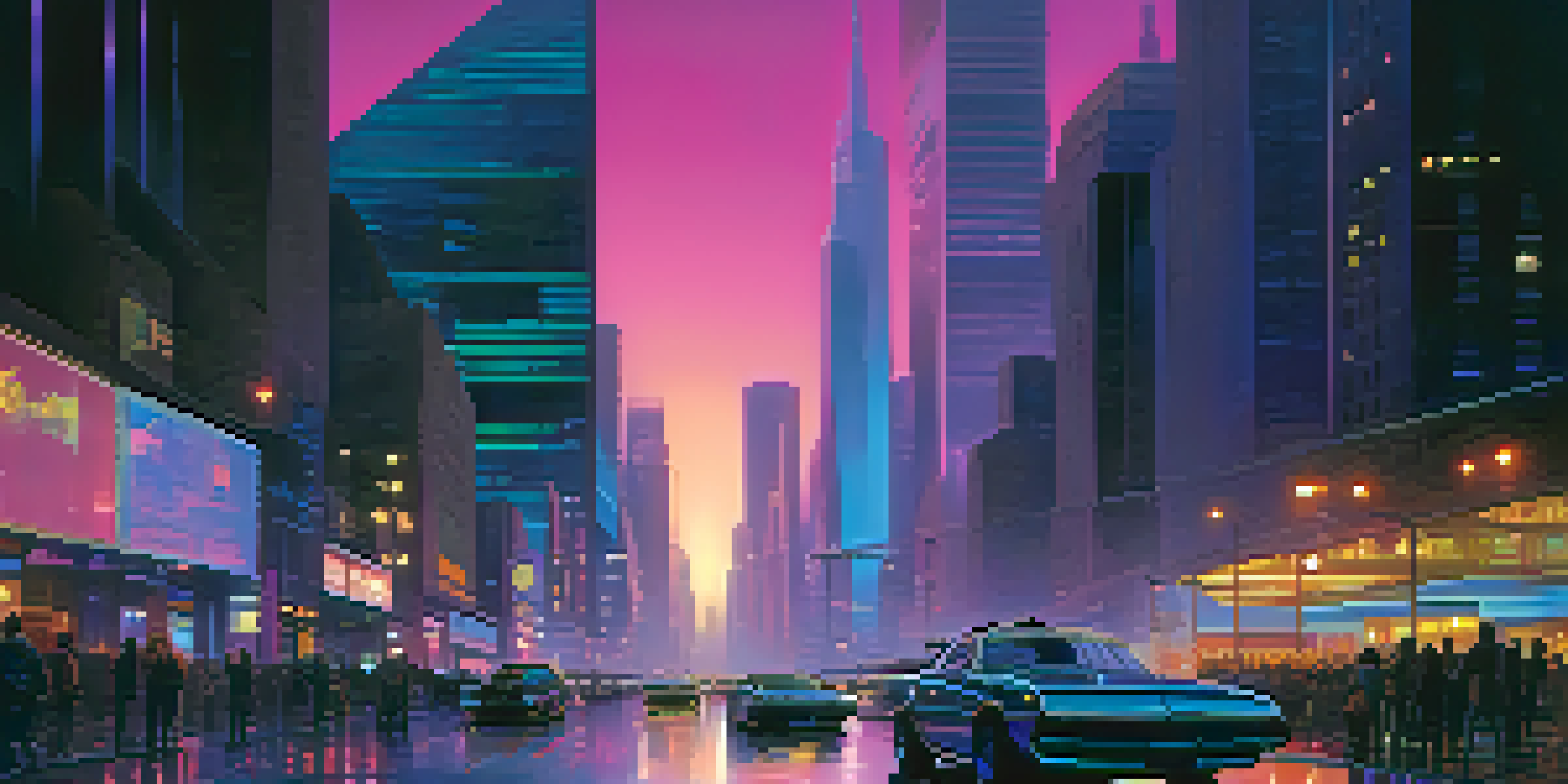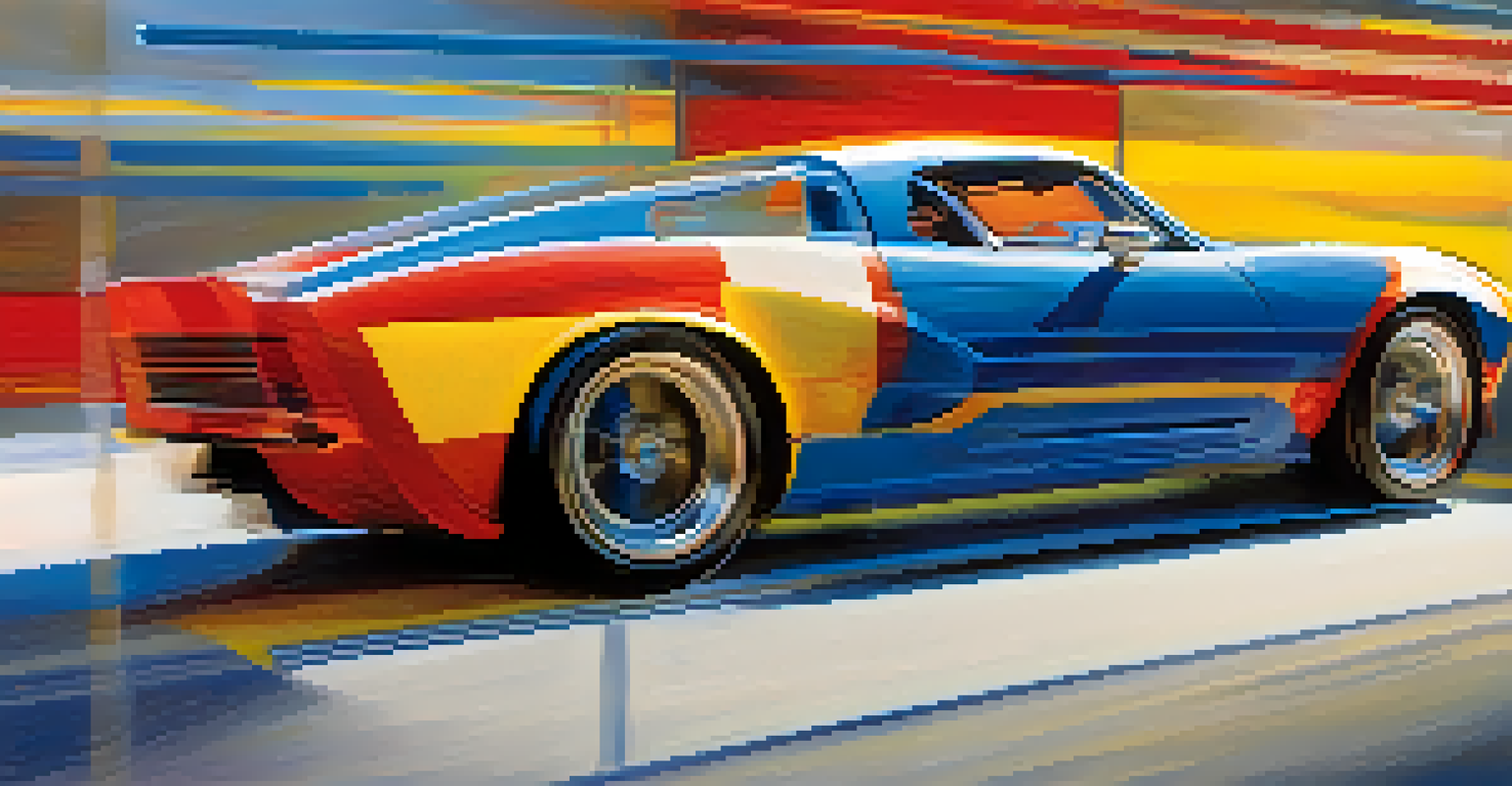Understanding Futurism: The Manifesto of Speed and Motion

What is Futurism? An Overview of the Movement
Futurism emerged in the early 20th century as a bold artistic and social movement. It sought to break away from the past and celebrate modernity, technology, and speed. Founded by Italian poet Filippo Tommaso Marinetti in 1909, the manifesto called for a new aesthetic that embraced the energy of the machine age. Futurism aimed to capture the excitement of a changing world, making it a revolutionary force in art and culture.
The past never takes a breath, it is always in motion, always in flux.
This movement wasn't limited to painting; it influenced literature, music, and even architecture. Futurist artists like Giacomo Balla and Umberto Boccioni used dynamic forms and vibrant colors to convey motion and energy. Their works often depicted the frenetic pace of modern life, reflecting the rapid advancements of the time. By embracing technology and speed, Futurism sought to redefine the way art interacted with society.
However, the movement was not without controversy. Critics argued that Futurism glorified violence and war, particularly as it became associated with Italian nationalism. Despite these criticisms, Futurism left an indelible mark on the art world, paving the way for subsequent movements like Dadaism and Surrealism.
The Key Themes of Futurism: Speed, Motion, and Technology
At the heart of Futurism are themes of speed, motion, and technology. Artists celebrated the dynamism of the modern world, portraying movement not just as a visual element but as a way of life. They believed that the speed of trains, cars, and airplanes symbolized progress and the future. The excitement of velocity was a central motif, reflecting the thrill of a rapidly changing society.

Motion was depicted through innovative techniques, such as fragmentation and multiple perspectives. For example, Boccioni's famous sculpture, 'Unique Forms of Continuity in Space,' captures the essence of movement, embodying the forward thrust of modernity. This focus on motion also extended to literature, where Futurist writers experimented with form and structure to evoke a sense of speed in their prose.
Futurism Celebrates Modernity
The Futurism movement emerged in the early 20th century, embracing themes of speed, technology, and the dynamism of modern life.
Technology, too, played a vital role in shaping the Futurist vision. The movement celebrated machines as products of human ingenuity, often seen as embodiments of power and revolution. This enthusiasm for technology marked a departure from traditional artistic values, as Futurists sought to embrace the new possibilities that the industrial age offered.
The Influence of Futurism on Art and Culture
Futurism significantly influenced various art forms, paving the way for modernism in the 20th century. Its embrace of technology and the avant-garde inspired artists across Europe to rethink their creative practices. Movements such as Cubism and Constructivism drew on Futurist ideas, incorporating aspects of speed and dynamism into their work. The legacy of Futurism can be seen in the evolution of contemporary art.
We will sing the love of danger, the habit of energy and rashness.
Additionally, Futurism extended beyond visual arts, leaving a mark on literature and music. Writers began to experiment with rhythm and structure in ways that echoed the Futurist obsession with speed. Composers, too, sought to capture the essence of movement in their music, leading to new genres that reflected the frenetic pace of modern life.
The impact of Futurism can even be felt in architecture, where designers began to incorporate fluid lines and innovative materials to embody the spirit of the movement. Buildings started to reflect the dynamism of the age, with a focus on functionality and modern design. This architectural evolution emphasized the importance of space and structure in representing cultural progress.
Futurism and Its Relationship with War
Futurism's relationship with war is complex and often controversial. The movement's founders viewed war as a necessary force for societal change, believing it could cleanse and rejuvenate society. This glorification of conflict was encapsulated in Marinetti's writings, where he celebrated the destructive power of war as a means to achieve progress. This perspective led many to associate Futurism with militarism and nationalism.
During World War I, many Futurist artists enlisted, believing they were contributing to a new cultural renaissance. Their involvement in the war effort was seen as an extension of their ideology, as they sought to embody the spirit of the movement through acts of bravery and sacrifice. However, the aftermath of the war prompted a reevaluation of these beliefs, as the devastation and loss led to a more critical stance on violence.
Controversial Ties to War
Futurism's glorification of war and nationalism led to significant criticism and a complex legacy as artists grappled with its implications.
In the later years, the darker implications of Futurism's glorification of war became apparent. The movement faced backlash as people began to question whether such ideals were truly beneficial or merely destructive. This shift in perspective led to a complex legacy, with Futurism being both celebrated for its innovations while also critiqued for its associations with violence.
The Decline of Futurism: Causes and Consequences
The decline of Futurism can be traced to several factors, including its controversial associations and the changing cultural landscape. As the world experienced the aftermath of World War I, many artists began to question the values that Futurism had promoted. The disillusionment that followed the war prompted a shift toward more introspective and abstract movements, such as Surrealism and Dadaism, which rejected the Futurist emphasis on speed and progress.
Additionally, the rise of Fascism in Italy impacted the Futurist movement significantly. Some Futurists aligned themselves with the regime, which further alienated them from the broader artistic community. This political association diluted the original ideals of Futurism, leading to a fragmented identity that struggled to resonate with the changing times.
Ultimately, the decline of Futurism did not erase its influence. While the movement may have faded, its ideas about speed, technology, and modernity continued to inspire future generations of artists. The legacy of Futurism is evident in modern art practices, as artists still grapple with the complexities of motion and the impact of technology on society.
Futurism Today: Its Relevance in Contemporary Culture
Despite its decline, Futurism remains relevant in today's culture, especially as we navigate an increasingly fast-paced world. The themes of speed, technology, and innovation are more pertinent than ever, resonating with our digital age where everything is instantaneous. Artists and thinkers continue to explore these concepts, often referencing Futurist ideals in their work as they address contemporary issues.
In the realm of visual arts, many contemporary artists draw inspiration from Futurist techniques and themes, such as the exploration of movement and abstraction. Exhibitions often showcase works that echo the Futurist fascination with technology and acceleration, demonstrating the enduring influence of the movement. This connection highlights how Futurism's core ideas continue to inspire new artistic expressions.
Lasting Impact on Art and Culture
Despite its decline, Futurism's core ideas continue to inspire contemporary artists, reflecting ongoing discussions about technology and societal progress.
Moreover, as society grapples with the implications of rapid technological advancements, the questions raised by Futurism about progress and its consequences are increasingly relevant. Discussions around the impact of technology on human life echo the sentiments expressed by early Futurists. In this way, Futurism serves as a historical lens through which we can better understand our current relationship with speed and innovation.
Conclusion: The Lasting Legacy of Futurism
Futurism, with its emphasis on speed, technology, and modernity, has left a profound impact on the art world and beyond. The movement challenged traditional notions of art, pushing boundaries and inspiring new forms of expression. While its controversial associations with war and nationalism have sparked debates, the core ideas of Futurism continue to resonate in contemporary culture.
As we reflect on the legacy of Futurism, it becomes clear that its influence extends far beyond its initial inception. Artists, writers, and thinkers continue to engage with the themes of motion and technology, exploring their implications in today's society. The ongoing dialogue surrounding these concepts highlights the movement's relevance in understanding our rapidly changing world.

In essence, Futurism remains a vital part of our cultural narrative, encouraging us to reflect on the complexities of progress, innovation, and the human experience. Its legacy serves as a reminder of the power of art to challenge conventions and inspire new ways of thinking, ensuring that the spirit of Futurism lives on.